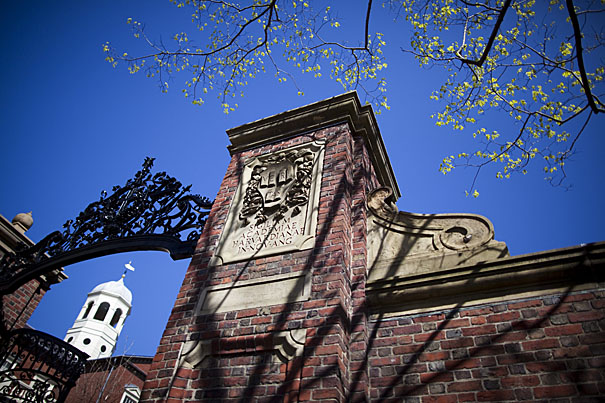
“We are delighted that so many of the nation’s and world’s best students have chosen to join us here in Cambridge,” said William R. Fitzsimmons, dean of admissions and financial aid. Johnston Gate graces one of the many entrances into Harvard Yard.
Stephanie Mitchell/Harvard Staff Photographer
Yielding strong results
More than 76% of undergrads admitted to Class of 2014 are expected to attend Harvard
The 2,110 students admitted to Harvard’s Class of 2014 have responded to their offers of admission so favorably that the final yield will likely exceed last year’s mark of 76 percent. They were selected from a pool of 30,489 applicants, the largest in Harvard’s history.
“We are delighted that so many of the nation’s and world’s best students have chosen to join us here in Cambridge,” said William R. Fitzsimmons, dean of admissions and financial aid. “First and foremost on their minds was the opportunity to learn from Harvard’s eminent faculty, and to do so across the many disciplines in cutting-edge academic facilities,” he said.
“Financial aid once again played an important role in ensuring that talented students from all economic backgrounds could come to Harvard,” said Fitzsimmons. “The unwavering commitment of President Drew Faust, Dean of the Faculty of Arts and Sciences Michael D. Smith, and Dean of the College Evelynn Hammonds to keeping Harvard’s doors open during these challenging economic times sends a powerful message that reaches far beyond our University,” he said.
More than 60 percent of the Class of 2014 will receive need-based scholarships, averaging $40,000 annually. Undergraduates will benefit from a record $158 million in grant assistance, and 70 percent will receive some form of financial aid.
“The current economic environment creates many challenges for families who seek the best educational opportunities for their sons and daughters,” said Sarah C. Donahue, director of financial aid. “We spoke with many parents and students over the past month about how to make Harvard affordable,” she said.
The high yield of admitted students means that Harvard will admit fewer students from the waiting list than in recent years. “Currently, we expect to be able to admit between 65 to 75 students,” said Marlyn E. McGrath, director of admissions. “We will begin the selection meetings this coming week and complete our work by July 1.”
At this time, the demographics of this entering class are similar to last year’s. Men make up 51 percent of the class, while the geographic origins of the incoming students show little change. The percentage of students who intend to concentrate in the humanities rose from 22.3 percent to 25.3. Interest in engineering showed a similar increase, from 9.2 percent to 11.1, while there was a decline in social science aspirants, from 25.7 percent to 22.3. Interest in other concentrations remained similar to last year’s class, with 25.1 percent designating biological sciences, 11.1 percent the physical sciences, 7 percent mathematics, 1.8 percent computer science, and 0.2 percent undecided. African Americans make up 9.8 percent of the class (9.6 percent last year), Asian Americans, 22 percent (19.1 last year), Latinos, 7.9 percent (9.2 last year), and Native Americans, 1.6 percent (1 percent last year).
Harvard’s April Visiting Program, directed by Admissions Officer Valerie Beilenson, once again provided a warm welcome for admitted students and their families. Faculty members, administrators, and current undergraduates contributed their time and enthusiasm. Undergraduates — through the Undergraduate Admissions Council, the Undergraduate Minority Recruitment Program, and the Harvard Financial Aid Initiative — telephoned and e-mailed admitted students and hosted students in Cambridge.
Members of the admissions staff, including David L. Evans, director of the Undergraduate Admissions Council, Roger Banks, director of minority recruitment, and Patrick Griffin, director of the Harvard Financial Aid Initiative, ensured that the admitted students had the opportunity to learn more about Harvard before making their final college choices. Alumni and alumnae hosted numerous “admit parties” and telephoned admitted students in their local areas, answering their questions and encouraging them to enroll at Harvard.
In 2004, Harvard introduced the first in a series of financial aid initiatives that have greatly expanded the College’s appeal to students from many backgrounds. This program asks for no parental contribution from those with annual incomes under $60,000, and only modest contributions from families with incomes of $60,000 to $80,000.
A program announced in 2007 for middle and upper-middle income families has made many additional students eligible for expanded aid. Families with incomes up to $180,000 a year and typical assets are now asked to contribute from zero to 10 percent of their incomes. Home equity has been removed from financial aid calculations, and loans are no longer required.
Harvard admissions officers will be on the road next week, traveling jointly with four other colleges to recruit students for the Class of 2015. By the end of May, they will have visited 60 cities and will visit 60 more in the fall with the same travel group.
In addition, letters will be sent to thousands of prospective applicants during May, providing the foundation for outreach to the most promising students from around the world. “The students who will join us in the fall as members of the Class of 2014 inspire us to continue our year-round pursuit of the next generation of Harvard students,” said Fitzsimmons.




